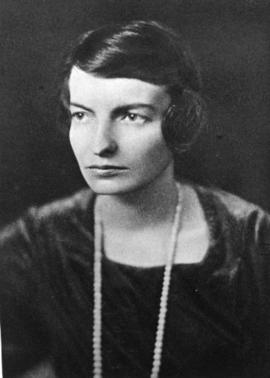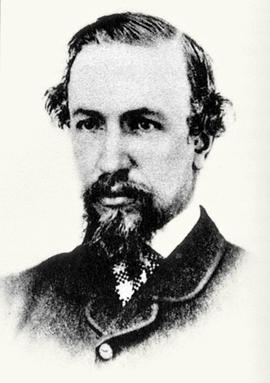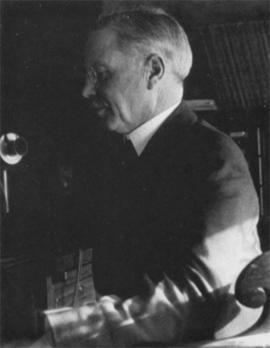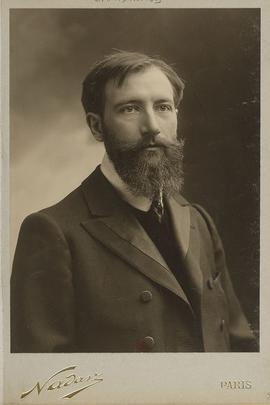Joan Beauchamp Procter was a British zoologist and herpetologist. She worked initially at the British Museum (Natural History) and later at the Zoological Society of London, as the first female Curator of Reptiles at London Zoo. She undertook substantial taxonomic work and made innovative contributions to veterinary practice and zoo displays. She wrote scientific and popular zoological articles, including early accounts of the behaviour of captive komodo dragons.
Arthur Loveridge was a British biologist and herpetologist who wrote about animals in East Africa, particularly Tanzania, and New Guinea. He gave scientific names to several gecko species in the region. In 1924, he joined the Museum of Comparative Zoology in the grounds of Harvard University, where he was the curator of herpetology. He returned to East Africa on several field trips and wrote many scientific papers before retiring from Harvard in 1957. On retirement, they moved to Saint Helena in the South Atlantic, from where he continued his interest in natural history, publishing several articles on the island's wildlife in the St Helena Wirebird and St Helena News Review in the 1960s & 1970s. Several species and subspecies of reptiles are named in his honor, including Afroedura loveridgei, Anolis loveridgei, Atractus loveridgei, Elapsoidea loveridgei, Emoia loveridgei, Gongylophis colubrinus loveridgei, Melanoseps loveridgei, Philothamnus nitidus loveridgei, and Typhlops loveridgei.[1]
Three species of endemic St Helenian insect were named after him. the cranefly Dicranomyia loveridgeana, the blackfly Simulium loveridgei, and the subgenus Loveridgeana of the hoverfly genus Sphaerophoria, with Spherophora (Loveridgeana) beattiei known on the island as Loveridge's hoverfly. His insect collecting satchel is on display in the St Helena Museum in Jamestown
Karl Patterson Schmidt was an American herpetologist. From 1916 to 1922, he worked as scientific assistant in herpetology at the American Museum of Natural History in New York, under the American herpetologists Mary Cynthia Dickerson and Gladwyn K Noble. He made his first collecting expedition to Puerto Rico in 1919, then became the assistant curator of reptiles and amphibians at the Field Museum of Natural History in Chicago in 1922. From 1923 to 1934, he made several collecting expeditions for that museum to Central and South America, which took him to Honduras, Brazil and Guatemala. In 1937, he became the editor of the herpetology and ichthyology journal Copeia, a post he occupied until 1949. He became the chief curator of zoology at the Field Museum in 1941, where he remained until his retirement in 1955. From 1942 to 1946, he was the president of the American Society of Ichthyologists and Herpetologists. In 1953, he made his last expedition, which was to Israel
Osbert Salvin was an English naturalist, ornithologist and herpetologist, best known for co-authoring Biologia Centrali-Americana (1879-1915) with Frederick DuCane Godman. In 1871 Salvin became editor of The Ibis. He was appointed to the Strickland Curatorship in the University of Cambridge, and produced his Catalogue of the Strickland Collection. He was one of the original members of the British Ornithologists' Union. He produced the volumes on the Trochilidae and Procellariidae in the Catalogue of Birds in the British Museum. One of his last works was the completion of Lord Lilford's Coloured Figures of British Birds (1897). Salvin was a Fellow of the Royal Society, the Linnean, Entomogical and Zoological Society of London. At the time of his death he was Secretary of the British Ornithologists' Union.
Charles Robert Senhouse Pitman was a herpetologist and conservationist. From 1925 to 1951 he was Game Warden of the Uganda Protectorate. He was active with conservation and preservation groups such as the Elsa Foundation, the Fauna Preservation Society and the Rare Breeds Survival Trust
John Van Denburgh was an American herpetologist from California. In 1895 he organised the herpetology department of the California Academy of Sciences. He practiced medicine in San Francisco while serving as curator of the herpetological collections of the California Academy of Sciences. After the San Francisco earthquake of 1906 he was instrumental in rebuilding the lost herpetology collections through new expeditions and acquisitions of other collections. In 1922 he published the two-volume The Reptiles of Western North America. He discovered and described at least 38 species of reptiles
Malcolm Arthur Smith was a herpetologist and physician working in the Malay Peninsula. Smith went on to become the physician in the royal court of Siam and was a doctor to the royal family. He published his observations on the reptiles and amphibians during his stint there and was in regular correspondence with Boulenger at the Natural History Museum in London. He left in 1925 to continue his studies at the museum in London. He was the founder and president of the British Herpetological Society
Albert Karl Ludwig Gotthilf Günther, also Albert Charles Lewis Gotthilf Günther was a German-born British zoologist, ichthyologist and herpetologist. He is ranked the second-most productive reptile taxonomist (after George Albert Boulenger) with more than 340 reptile species described. He served on the council of the Zoological Society of London for nearly 40 years (1868-1905)
Paul Chabanaud was a French ichthyologist and herpetologist. Beginning in 1915, he worked as a volunteer under zoologist Louis Roule at the Museum National d'Histoire Naturelle in Paris. In 1919-1920, he undertook a scientific expedition to French West Africa (Senegal, Guinea) on behalf of the museum, during which he collected thousands of zoological specimens. Following his return to Paris, he served as a preparator in the laboratory of biologist Jean Abel Gruvel at the museum. He specialised in the anatomy and systematics of the flatfish and was the taxonomic authority of many herpetological and ichthyological species
Emmett Reid Dunn was an American herpetologist noted for his work in Panama and for studies of salamanders in Eastern United States. He served as editor of Copeia from 1924 to 1929




